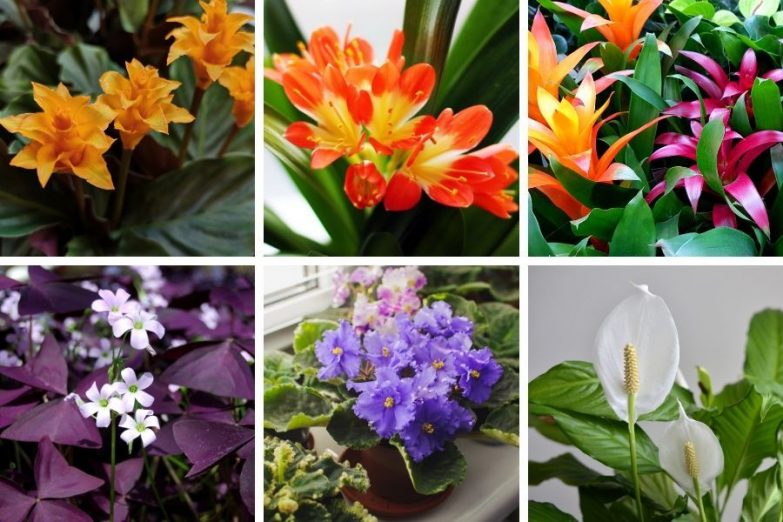Flowering houseplants bring beauty and color to your home, provide a great conversation piece for visitors, and bring joy no matter what season it is outside. Although many flowering houseplants require a lot of light, there are quite a few low light flowering indoor plants that will grow and thrive even in low light homes.
15 Of My Favorite Low Light Flowering Indoor Plants
Here are 15 of my favorite low light flowering indoor plants, with details on how to care for them, so you can enjoy beautiful blooms throughout your home. If you’d like to learn how to keep these plants thriving year after year, check out my book, “Houseplants Made Easy”.
Phalaenopsis Orchids
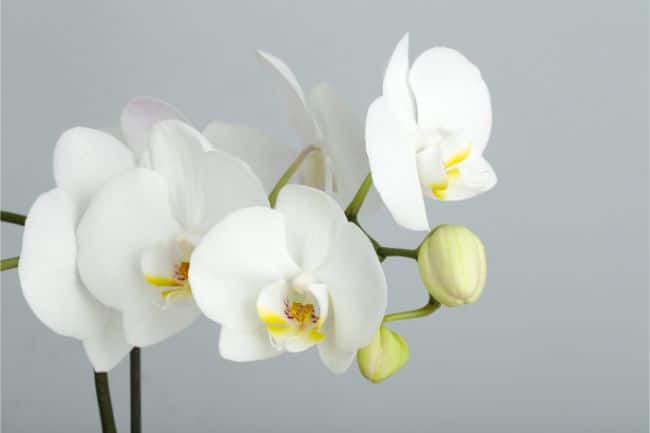
The Phalaenopsis, or moth orchid looks like a delicate tropical plant with its stunningly beautiful flowers and graceful stems. However, this beauty not only thrives in low light situations, it also is very easy to care for and inexpensive to purchase.
You can generally find phalaenopsis orchids in all colors and sizes everywhere from your local grocery store, big box store, to garden center or nursery. Phalaenopsis orchids are reasonably priced, easy to find, and fun to grow.
When purchasing a phalaenopsis orchid, look for a plant with bright green leaves, firm roots, and a sturdy stem. Caring for these beauties is so easy; keep them in a bright room but out of direct sunlight. These orchids will readily tolerate low light, as well.
Water thoroughly, but don’t let your orchid sit in water, and fertilize every one to two weeks. Don’t throw away your orchid if it stops blooming. Just keep taking care of it, and it should soon bloom again!
It’s no wonder these lovely plants are so popular. They thrive in low light with very little care and in return, offer up beautiful exotic blooms for you to enjoy.
Read my guide to growing beautiful phalaenopsis orchids here.
Kalanchoe blossfeldiana (Flaming Katy)
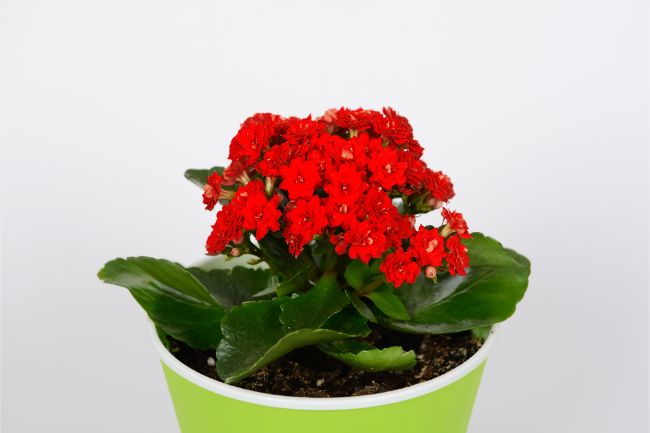
Kalanchoes, or Flaming Katies, will add a bright pop of color to any room. These hardy succulents are very easy to grow but provide plenty of tiny, long-lasting, bright blooms in a dazzling array of colors.
You can care for a kalanchoe just like you would any succulent. Keep it in well-draining, sandy soil and water it thoroughly, then allow all of the water to drain away. Don’t water the plant again until the top half inch of soil has dried out again.
Flaming Katies don’t need direct sunlight, in fact, any bright room will do just fine for your plant. If you don’t have access to sunlight, your kalanchoe will do fine for months with only low light conditions.
Largely treated as an annual, but they will bloom year after year if you provide the right conditions. You’ll need to give it a rest period of about 15 hours per day of complete darkness for several weeks. Once your flaming katie develops buds again, you can stop putting the plant into darkness and allow the brilliant colored blooms to open up.
Guzmania Bromeliads
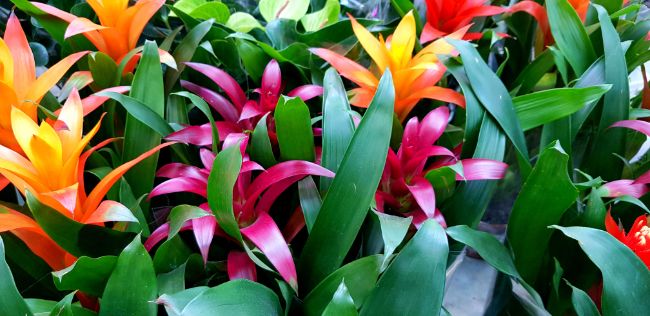
This gorgeous epiphyte is a great choice for low light offices and homes. It will happily bloom in low light, fluorescent light, or any other type of indoor lighting. However, these bromeliads do not tolerate direct sunlight at all. While these plants will be just fine in low light, the blooms will not last as long as they would if you put them in a brighter room.
These brightly colored blooms can be orange, yellow, red, pink, or even a deep purple with thin dark green leaves growing at the base. Water the plant at its base, or cup, replacing the water frequently so it does not stagnate and grow bacteria. Since these plants like a little bit of humidity, you may want to place the plant on a pebble tray in order to increase the humidity around it.
These plants are popular because of their ease of care and lower light needs. However, eventually, the plant will stop blooming and the mother plant will die, hopefully leaving behind some baby plants, called pups, which will grow into new plants that will provide more stunning blooms for you to enjoy.
Read my guide to growing guzmania bromeliads for the complete run down on keeping them looking great.
Spathiphyllum wallisii (Peace Lily)
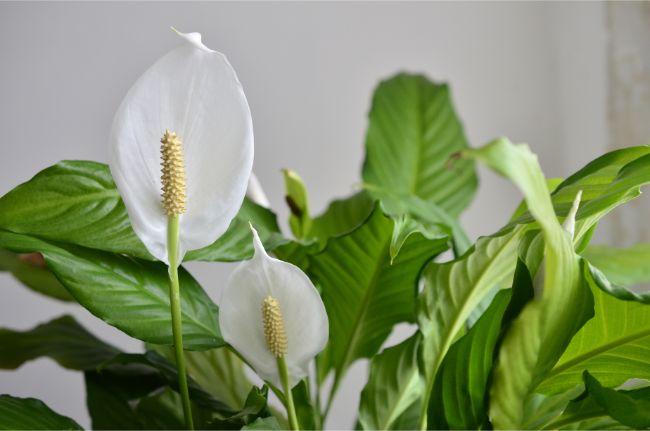
The peace lily, or Spathiphyllum, shows off beautiful white leaves or bracts, that look like blooms. This low light flowering indoor plant is highly adaptable, easy to care for, and will thrive in very low light homes and offices.
Peace lilies enjoy typical household temperatures and lighting, so there is no need to be too fussy. Your peace lily will tell you when it needs to be watered by drooping its leaves. Try to water your peace lily just before it starts to droop. Don’t be alarmed if yours does suddenly collapse, as a good drink of water will usually revive it.
These plants are available in all sizes, from countertop size to several feet tall. These plants are great for beginner gardeners, those with black thumbs, and anyone who loves its beautiful blooms. However, some websites claim this plant is toxic to animals and small children, so proceed with caution if you have either in your home.
Oxalis triangularis (Purple Shamrocks)
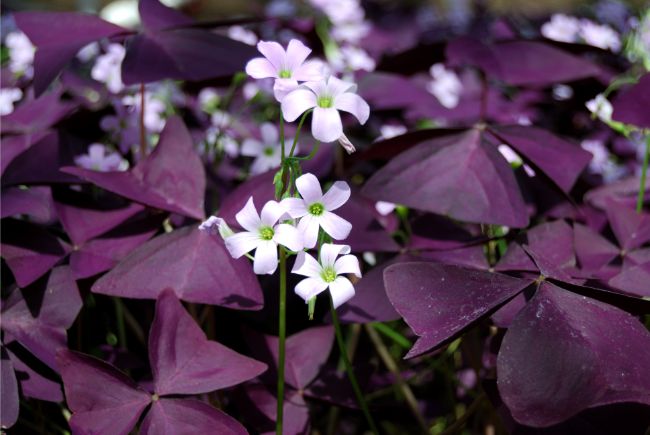
This unique low light flowering indoor plant is sure to be a conversation piece in your home or office. Also called a false shamrock or purple shamrock, it grows in three-leaf clusters of deep purple and shoots up delicate pink-purple blooms. At night, or under stress, these delicate leaves and blooms will close up like butterfly wings.
Oxalis triangularis love indirect lighting. While they will be ok for short periods in low light, very dark homes may cause it to become leggy and spindly. However, caring for this plant is easy and almost foolproof. Read my article on oxalis triangularis care for more info.
Oxalis triangularis will do well in typical home temperatures. It thrives in well draining soil and leaves will close up tight if it is a little overdue for a drink of water. These plants occasionally go dormant, induced by the end of the growing season, lack of water, or high temperatures. If so, stop watering and allow the plant to dry up. Once leaves begin to appear again, you can resume watering as normal.
Cyclamen
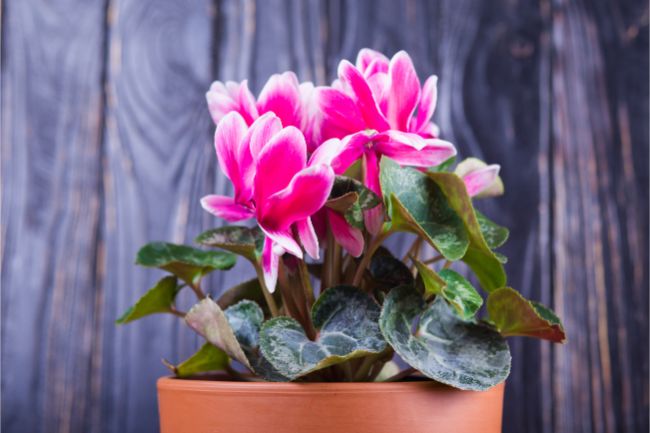
Cyclamens blooms resemble shooting stars with their windswept appearance, hovering over a base of thick variegated leaves. These sweet and beautiful plants will bloom for several months under the right conditions, then die back and go dormant until they are ready to grow and bloom again.
Cyclamens don’t like to overheat, so the cooler temperatures of a home will work just fine. While these plants prefer bright, indirect light during the winter growing season, they can do fine with just a little ambient lighting in a brighter room. However, once the plant goes dormant for the summer, it will be just fine in a dim space until it is ready to grow again.
Water cyclamens carefully. They don’t like to sit in water, but they do like slightly moist soil that does not dry out completely. Avoid getting water on the leaves and flowers, and water only the soil, instead.
Clivia (Kaffir Lily)
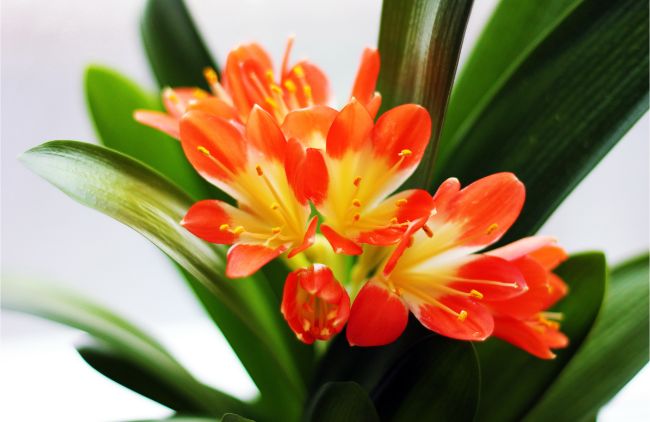
As a relative to the amaryllis, the clivia plant has similar characteristics: a large cluster of trumpet shaped blooms in bright colors sits atop a sturdy stem, with foliage sprouting at the bottom. However, clivias will bloom longer and require less care than its better-known cousin.
While clivia plants prefer bright indirect light, they do not tolerate direct sunlight well, and once blooming, will tolerate low light conditions for many months without suffering too much.
Kaffir lilies prefer their soil to be on the dry side, so be careful not to overwater. And they will bloom better if they are pot-bound, so don’t be in a rush to place them in a bigger pot. After the blooming period has ended, your clivia will need a rest period with lower light, less water, and cooler temps. When this is done, it should begin to bloom again.
Read my article on how to care for Clivia plants to learn everything you need to know about growing this stunning low light flowering indoor plant.
Amaryllis
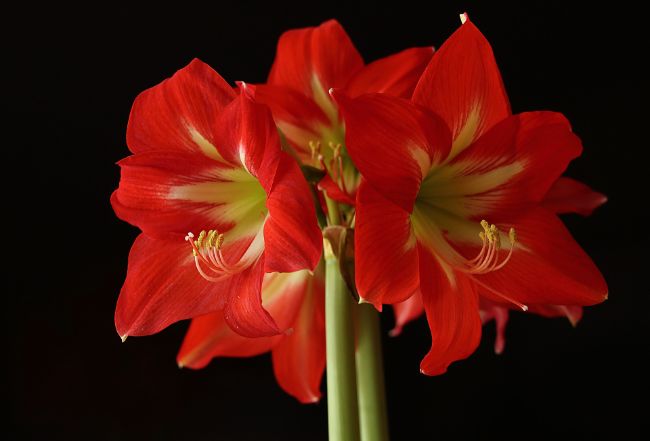
Long known for their ease of forced blooming, the amaryllis will certainly make a graceful addition to your space with its large bright cluster of cone-shaped flowers perched on a tall stem. Once an amaryllis bulb puts out shoots, it needs about 4 hours per day of direct sunlight.
However, after it begins to bud, you can remove it from direct sun and place it in a bright room, where it will do just fine without any direct light. In fact, lower light will preserve the blooms for a longer period of time.
Water the amaryllis once the surface of the soil feels dry, allowing water to flow freely from the drainage holes. Once the blooms are spent, the plant will die back and need a rest period in the fall.
You can put the bulb in the fridge or other cool place for six weeks to get ready to begin the blooming process again, just don’t expose it to freezing temperatures or the bulb might die.
Anthurium (Flamingo Flower)
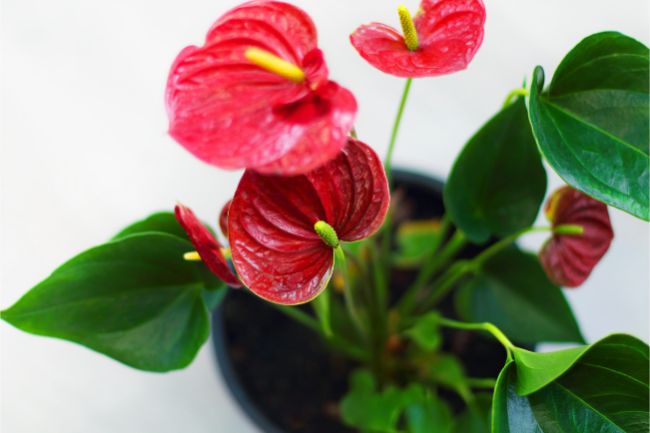
Anthuriums boast bright red, striking shiny blooms. Other colors are a little harder to acquire, but they can be found in colors such as pink, orange, deep purple, and almost black.
These striking flowering houseplants can grow reasonably well in all levels of indirect light, but very low levels of light may cause the plant to grow more slowly and produce less blooms. Keep your anthuriums away from direct sunlight, as this can burn the plant.
These beautiful plants are surprisingly easy to care for. They like a well-draining soil, so a mix of half potting soil to half perlite will create a soil that is just right for your plant.
You only need to water anthuriums when the soil becomes dry to the touch. Overwatering will cause root rot, so it’s better to make sure the soil is dry before watering again.
Schlumbergera (Holiday Cactus)
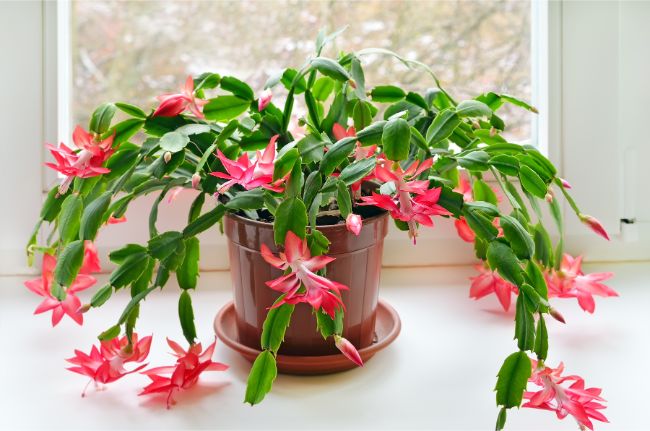
The holiday cactus, sometimes called the Christmas cactus and even Easter and Thanksgiving cactus, is often given as gifts during the holiday season. You’ll find these intricate plants in an array of colored blooms, with long tendrils of flowers in red, orange, yellow, pink, and white hanging off of spiny green segmented foliage.
Holiday cacti are often considered family heirlooms. When cared for correctly, these plants can be passed down from generation to generation. Each year, they will be larger and covered in even more blossoms.
These plants will do great in a well-draining soil. When the top inch or so of soil feels dry to the touch, water the plant thoroughly until water runs out the bottom. Discard any water in the tray and don’t water again until the soil feels dry to the touch.
Although these plants do best in bright indirect light, if you aren’t planning on keeping yours after the holiday season, they make great low light flowering indoor plants.
However, if you plant to keep it for the following year, you can help your plant to bloom again by giving it 14 hours of darkness each night for six weeks. Once it develops buds again, you can bring it back into the typical lighting in your home.
Poinsettia
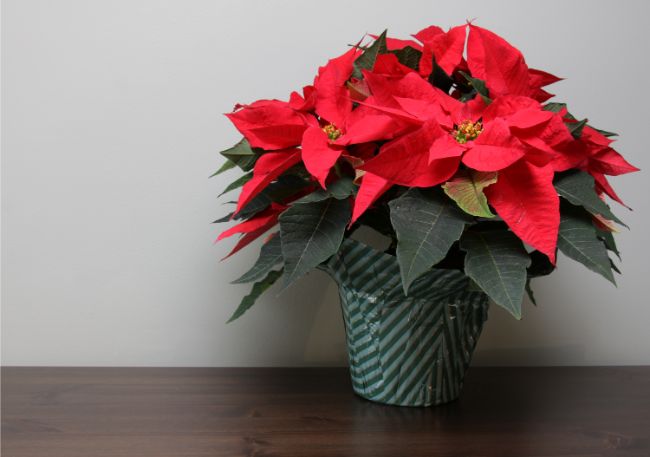
While poinsettias are famous for their splashy red blooms at Christmas time, they can also be found in white, cream, lemon, pink, and variegated colors. Although these plants like bright light during the summer, they actually bloom in response to the long nights of winter, and make perfect low light flowering indoor plants.
Most people treat poinsettias as annuals, buying them in the run up to Christmas when they are already in full bloom. Once blooming, poinsettias will tolerate lower light for months on end as they display their spectacular, vibrant bracts to brighten up your home.
Poinsettias like their soil to be a little bit damp, but never soggy or soaked. If the soil feels dry, give it a good drink but don’t let the plant sit in puddles of water. Average room temperatures should be just fine for your poinsettia, as well.
Read my guide to caring for poinsettias, including how to make them rebloom year after year.
Saintpaulia (African Violets)
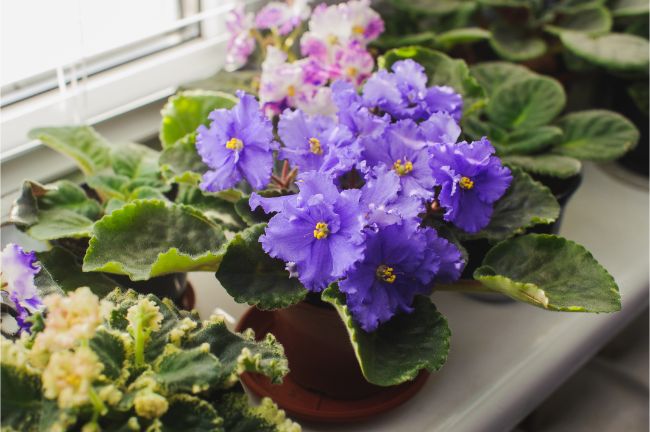
African Violets are very popular flowering houseplants for their spritely and dainty blooms and ease of care. Sweet clusters of flowers in lavenders, pinks, and yellows sit overtop of fuzzy little leaves.
African Violets will grow reasonably well under low light conditions, however, they do prefer bright indirect light when possible. If your leaves look leggy or dark green, or your plant refuses to bloom, you may need to find it some more light. But if it begins to look pale or bleached, then the light is too strong.
I’ve written an article about how to keep your African Violets blooming which you might find useful.
Keep the soil moist by watering your African Violet from underneath by setting the pot in a saucer of water. Only fertilize the plant if it needs a bit of a boost and keep it out of drafts.
Calathea Crocata (Eternal Flame Plant)
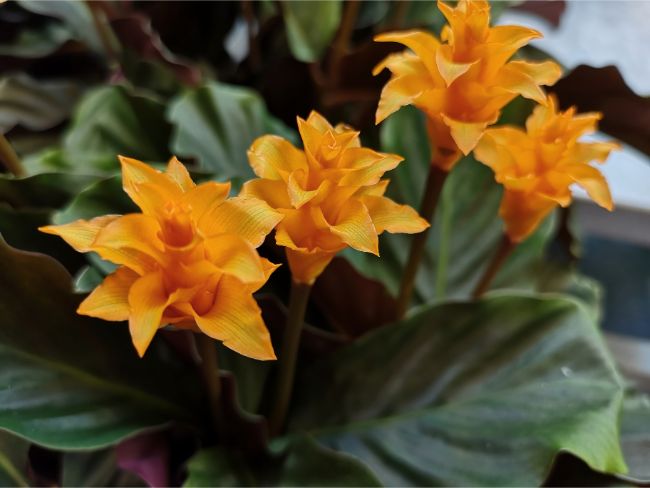
Also known as the eternal flame plant, the Calathea crocata bears beautiful yellow-orange blossoms that resemble a flame. Multiple blooms stand tall overtop of stiff green leaves, making for a striking plant that requires little care.
These plants do well in bright indirect light, and they even make fairly good low light flowering indoor plants. They prefer a slightly warm home – too cool or too hot can cause the plant to struggle.
Grow your Calathea crocata in a lightweight potting mix that drains well. Water it roughly once a week in the growing season and less often in the dormant season. When you water the plant, allow the water to run through and then don’t water it again until the soil begins to dry.
Being a jungle plant, the Calathea crocata prefers some extra humidity. You can set the pot on a pebble tray full of water to add humidity to the plant to keep it happy. Read my article on growing Calathea crocata to learn how to keep these wonderful blooms looking stunning.
Aeschynanthus Radicans (Lipstick Plant)
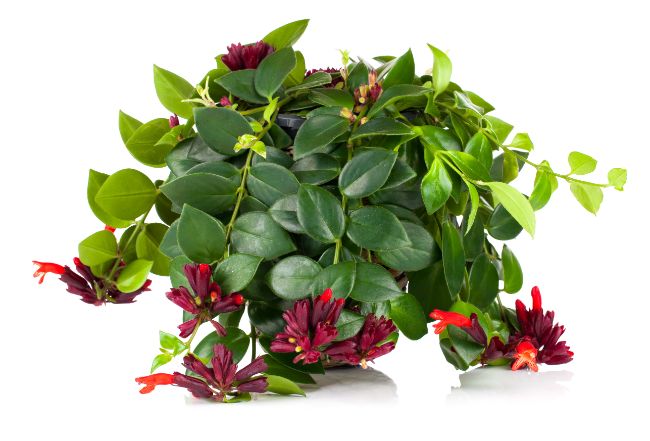
Lipstick plants, or Aeschynanthus, are a unique flowering plant that will brighten up any space. Bright red cones peek out from dark maroon tubes, resembling the shape of a lipstick and giving the plant its name. They are easy to grow with just a few minor considerations.
For soil, lipstick plants prefer a light airy soil that drains well. They are susceptible to root rot, so be careful not to overwater or allow the plant to remain in soggy soil.
In order for the plant to bloom, it needs slightly warm temperatures and just enough indirect light. If your plant does not bloom, you may need to move it to a brighter location or add some fluorescent lighting to give it a boost. However, your plant may grow and bloom just fine in lower lights. Learn more about looking after a lipstick plant here.
Begonias
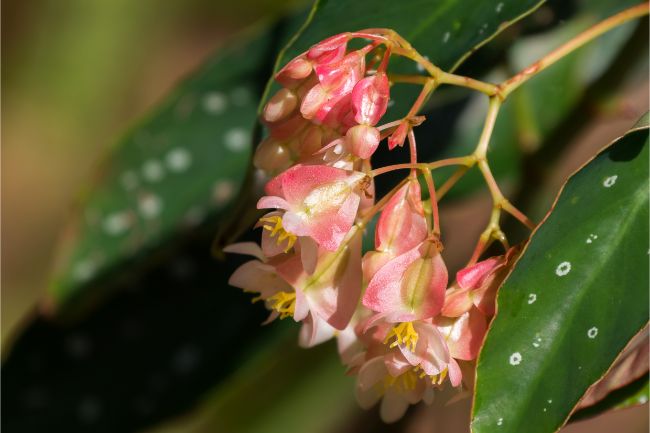
While begonias have a reputation for being shade loving annuals, there are certain species that make beautiful low light flowering indoor plants. Fibrous rooted begonias make wonderful flowering houseplants that will tolerate lower light and they come in a wide variety of colors and flower shapes.
Begonias are often grown in hanging baskets but will look beautiful on a pedestal or counter, as well. They need little care over the winter, although they do prefer extra humidity, especially in drier homes. If possible, place your begonia on a pebble tray with water to provide extra humidity for the plant.
Otherwise, you only need to water your begonias when the soil seems dry. It won’t hurt the plant if it droops a bit, just give it a thorough watering when you see it start to droop but don’t allow the roots to sit in soggy soil. Grow your begonias in bright indirect light for the best blooms.

